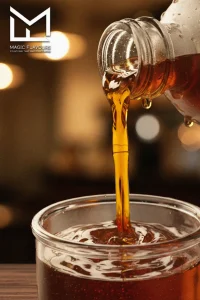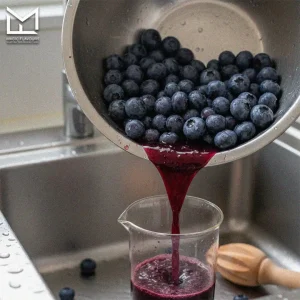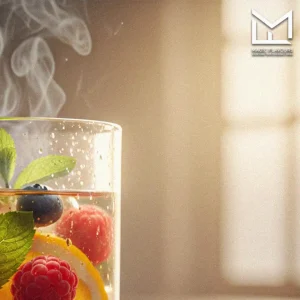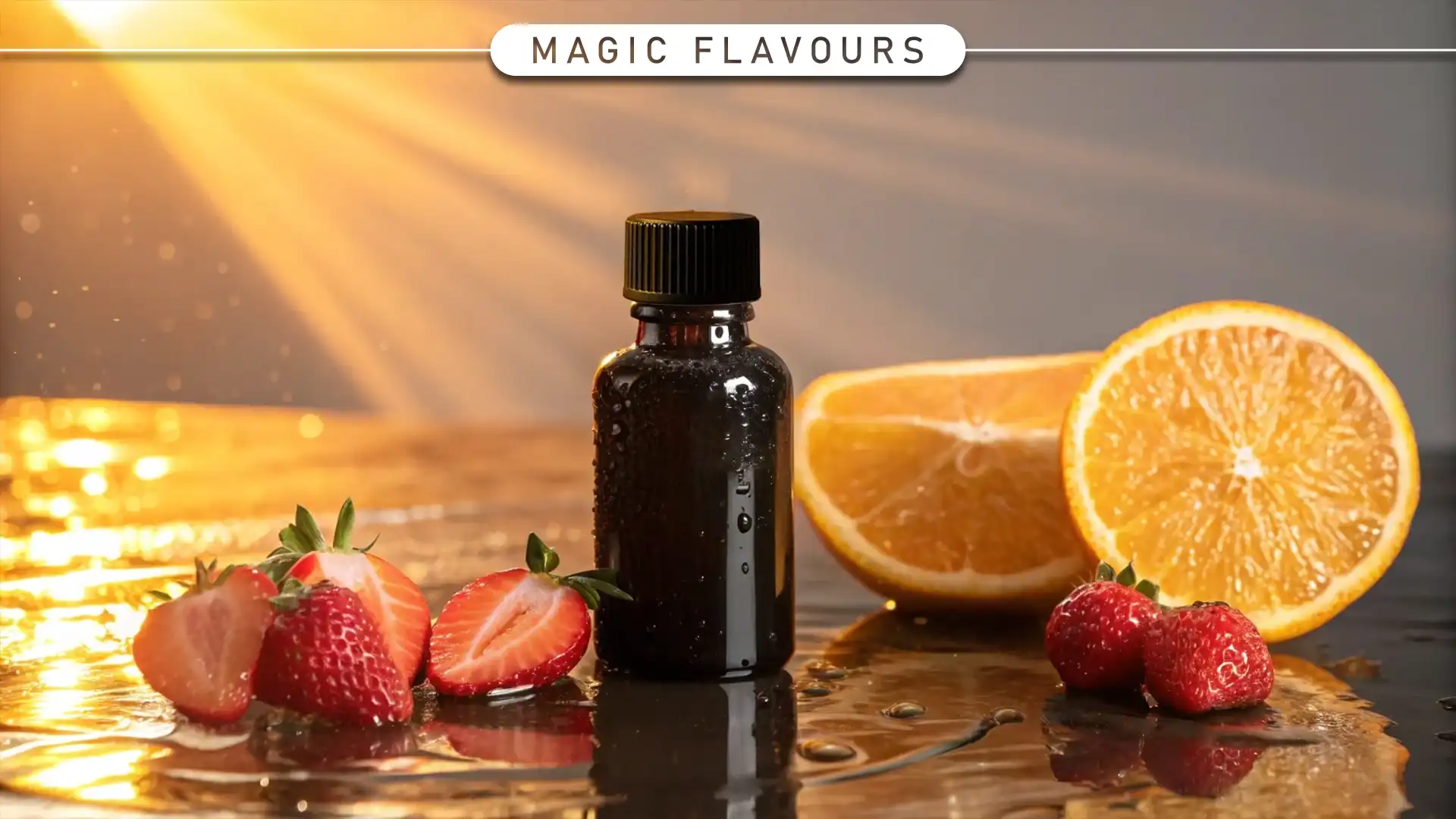1: Defining Fruit Essence
What Fruit Essence Really Is—and What It Isn’t
Fruit essence is the lightest form of fruit-derived flavor. It comes from the aromatic compounds released during juice processing.
First, steam or pressure helps separate volatiles from the juice. These volatiles are then condensed and collected. Because of this, this feels airy and clean.
It’s not a concentrate. It’s not an extract. It’s a top note—used to lift, not to build. So, it works best when paired with heavier flavor formats.
Volatile Capture vs Juice Concentrate
Juice concentrate delivers body and sweetness. Fruit essence delivers aroma and lift. That’s why they’re often used together.
Volatile capture happens early in processing. It preserves delicate aromatics before heat changes them. In contrast, concentrate comes later and feels heavier.
Together, they create balance. Essence adds brightness. Concentrate adds depth. So, the combination feels complete and emotionally satisfying.
Fruit Essence vs Extract vs FTNF
Essence comes as water-based and light. Extract delivers alcohol-based strength. FTNF brings fruit-derived complexity. Each format serves a different purpose.
Essence works well in beverages and sprays. Extract performs in baked goods and confections. FTNF supports clean-label storytelling.
Choosing the right format depends on application and audience. When used correctly, essence adds clarity without overpowering. So, it’s a strategic tool.
Why Terminology Matters in B2B Communication

In technical sales, words shape perception. “Essence” suggests lightness and purity. “Extract” suggests strength and concentration. That’s why clarity matters.
Mislabeling can cause confusion. It may affect regulatory claims or customer trust. So, teams must align on definitions early.
When R&D and marketing speak the same language, launches go smoother. Because of this, terminology becomes part of strategy.
2: How Fruit Essence Is Made
Steam, Separation, and Sensory Precision of Fruit Essence
Fruit essence begins with juice processing. First, steam or vacuum helps release aromatic volatiles from the fruit.
Then, these volatiles are separated and condensed. Because they’re captured early, they stay light and fresh.
This process preserves aroma without adding sweetness. So, this feels clean and focused.
The Role of Evaporation and Condensation of Fruit Essence

During juice concentration, water is removed. As it evaporates, it carries volatile compounds with it.
These volatiles are condensed and collected separately. That’s how this essence is formed—through gentle capture, not aggressive extraction.
Because the process avoids heat damage, the aroma stays true to the original fruit. So, it supports natural positioning.
Capturing Volatile Without Heat Damage
Heat can flatten aroma. That’s why this essence is captured before thermal processing begins.
Low-pressure systems help preserve delicate notes. In addition, timing matters—early capture protects freshness.
When done correctly, the result is a light, aromatic ingredient. So, it adds lift without heaviness.
Why Essence Feels Lighter Than Juice
Juice contains sugars, acids, and pulp. Essence contains only volatiles. That’s why it feels lighter and more aromatic.
Juice builds body. Essence adds brightness. Together, they create balance and emotional impact.
In flavor design, this contrast matters. So, essence becomes a tool for clarity and lift.
3: Clean-Label and Regulatory Insights
Fruit Essence and the Natural Claim
Fruit essence supports clean-label goals. It’s derived from real fruit, not synthetic compounds. That’s why it builds trust across categories.
In many regions, essence qualifies as “natural” under flavor regulations. This includes the US, EU, and parts of the Middle East. So, it helps brands meet consumer expectations.
Because it’s captured during juice processing, essence feels authentic. That’s why it works well in wellness and lifestyle formats.
Labeling Rules in the US, EU, and Middle East
In the US, fruit essence is often labeled as “natural flavor.” The FDA allows this when it’s derived from fruit and used for taste.
In the EU, labeling depends on origin and processing. If the essence comes directly from fruit, it may carry a “natural” claim. However, wording must be precise.
In the Middle East, rules vary by country. Some markets require clear separation between natural and nature-identical flavors. So, regulatory review is essential.
Consumer Perception: Natural vs Artificial Aroma
Consumers respond to clean language. “Fruit essence” sounds lighter and more natural than “artificial flavor.” That’s why it influences purchase decisions.
In addition, shoppers want transparency. They look for ingredients they can understand. So, essence helps simplify the label.
When brands explain how flavor is made, they build emotional trust. Because of this, it becomes part of the story.
Fruit Essence as a Storytelling Tool for Transparency
Origin matters. If the essence comes from fresh fruit, that detail adds value. So, brands should highlight sourcing when possible.
Processing also matters. Steam capture or gentle separation feels cleaner than chemical extraction. That’s why it supports wellness positioning.
When teams align on language, storytelling becomes easier. Because of this, this helps bridge technical and emotional goals.
4: Application Spotlight
Beverages: Juices, Waters, and Functional Shots
Fruit essence works well in beverages. It adds aroma without sweetness. That’s why it’s used in waters, juices, and shots.
In functional formats, it masks off-notes and adds freshness. So, it supports wellness positioning and clean-label goals.
Because it’s light and water-soluble, this blends easily. That’s why it performs well in low-calorie and minimalist drinks.
Confectionery: Gummies, Chews, and Sprays
In confectionery, it adds top notes. It lifts flavor without adding bulk. That’s why it’s used in sprays and fast-release formats.
Gummies and chews benefit from aroma contrast. When paired with juice or FTNF, essence adds brightness. So, the flavor feels more complete.
Because its volatile, essence works best in sealed formats. That’s why packaging matters in confectionery applications.
Wellness: Supplements and Nutraceuticals
Fruit essence helps improve compliance. It masks bitterness and adds comfort. That’s why it’s used in tablets, powders, and effervescents.
In addition, it supports natural claims. When derived from fruit, it feels clean and trustworthy. So, it aligns with health-forward branding.
Essence also performs well in dissolvables and sprays. Because of this, it supports innovation in wellness formats.
Hookah Molasses: Aroma Enhancement Without Overload
In hookah molasses, fruit essence adds lift. It enhances aroma without adding heaviness. That’s why it’s used in top-note layering.
It pairs well with mint, smoke, and vanilla. These combinations feel modern and balanced. So, essence supports both classic and trendy blends.
Because heat affects volatiles, stability tools matter. When formulated well, this delivers a smooth, aromatic session.
5: Strategic Formulation Tips
Layering with Juice, FTNF, and Extracts
Fruit essence works best when layered. It adds aroma, while juice and FTNF add body and depth. That’s why they’re often used together.
First, essence lifts the top note. Then, FTNF builds authenticity. Juice adds sweetness and texture. So, the combination feels complete.
In confectionery and beverage formats, this layering creates emotional impact. Because of this, flavor feels more natural and satisfying.
Volatile Stability and Packaging Considerations

Volatiles are sensitive. They can fade with heat, light, or oxygen. That’s why packaging matters.
Sealed formats protect aroma. In addition, low-temperature processing helps preserve freshness. So, stability tools should be considered early.
When teams plan for volatility, fruit essence performs better. Because of this, shelf life and sensory quality improve.
Cost Efficiency and Sensory Payoff of Fruit Essence
Fruit essence is concentrated. A small amount adds noticeable aroma. That’s why it supports cost-effective formulation.
In low-dose formats, it delivers lift without adding bulk. So, it’s ideal for sprays, gels, and dissolvables.
When paired with heavier formats, essence adds clarity. Because of this, brands can reduce load while maintaining impact.
6: Market Trends and Innovation Drivers
Clean-Label and Minimalist Formulation Trends
Brands are simplifying. They want fewer ingredients and clearer labels. That’s why fruit essence is gaining attention.
It adds aroma without adding sugar, acid, or bulk. So, it supports minimalist formulation goals.
In addition, it aligns with wellness positioning. When derived from real fruit, it feels clean and trustworthy.
Consumer Desire for Light, Natural Aromatics
Consumers want flavor—but not overload. They prefer light, natural aromatics. That’s why fruit essence performs well.
It adds freshness without heaviness. In addition, it feels familiar and safe. So, it builds emotional comfort.
This matters in wellness and lifestyle formats. Because of this, this supports repeat purchase and brand loyalty.
Essence in Emerging Formats: Sprays, Gels, and Drops

New formats need flexible flavor tools. Fruit essence works in sprays, gels, and dissolvables. That’s why it supports innovation.
It’s water-soluble and low-dose. So, it performs well in fast-release and portable formats.
In addition, it blends easily with botanicals and actives. Because of this, it helps brands stay ahead of the curve.
7: Conclusion
Fruit Essence: A Small Ingredient with Big Potential
Fruit essence adds aroma, clarity, and emotional lift. It’s light, clean, and versatile. That’s why it performs across categories.
In addition, it supports clean-label goals and minimalist formulation. So, it fits both wellness and indulgent formats.
When used with care, this becomes more than a flavor—it becomes a strategic signal of quality and trust.
Final Takeaways for R&D and Marketing Teams

R&D teams should explore layering, stability, and dose efficiency. Marketing teams should shape clear language and origin stories.
Cross-functional alignment matters. When flavor and brand teams collaborate early, fruit essence performs better.
Because it’s subtle but powerful, fruit essence needs thoughtful positioning. So, it becomes a signature—not just a support.
Sampling, Testing, and Storytelling
Now’s the time to explore fruit essence. Request samples, test blends, and build new formats. Because hands-on work drives insight.
In addition, use storytelling to highlight sourcing and process. That’s how fruit essence builds emotional connection.
Innovation starts with curiosity. So, ask questions, challenge assumptions, and create something fresh. Fruit essence is ready—and your next launch could prove it.
